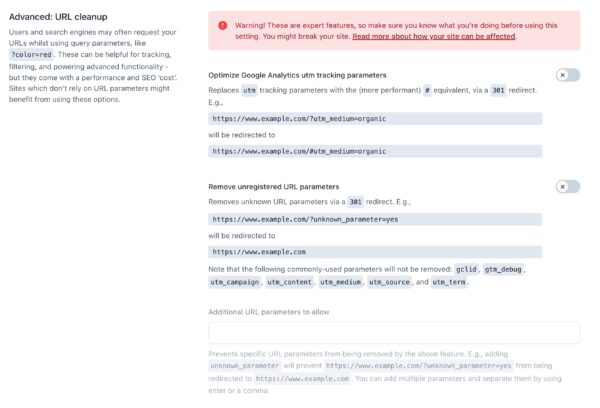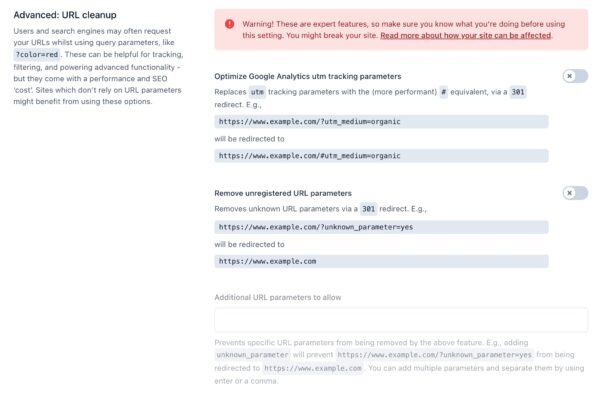Advanced Crawl optimization settings: URL cleanup
The URL cleanup feature in the Crawl optimization settings helps to reduce the impact of URL parameters on your site’s performance and security. Please note that it is an advanced feature designed for power users, and an incorrect configuration can hurt your site. Every site works differently and will need its own unique configuration.If you want to take advantage of this feature, you should make sure that you understand how URL parameters work, if they’re used on your website, and how they work.

What are query parameters, and how do they work?
When people link to your site, they may choose to add parameters to the URL: it provides additional information to the website. For example, an email marketing campaign may add ?source=email or ?from=example.com to the campaign’s URLs. This way, your can identify were your site traffic comes from. This kind of functionality is common with tracking systems like Google Analytics.
You might also use parameters to power parts of your site’s functionality. For example, a calendar plugin might let you browse to specific dates by appending parameters like ?year=2021&month=01&day=01 to the URL. This approach is also common in e-commerce websites, for filtering categories and products.
Lastly, it’s important to understand that any user or website can link to your pages using query parameters. It’s common for crawlers, systems, social networks, software, and third-party tools to append query parameters to the URLs they crawl and request.
Query parameters can cause SEO problems
In some scenarios, parameters can cause SEO problems, because example.com and example.com/?source=email are technically different URLs. Search engines and crawlers must now crawl more URLs and identify these pages as duplicate content. Even if you’re using canonical URLs, those extra URLs still represent an additional cost to the crawling and indexing processes. They might also impact your site’s performance, as it’s harder to cache and optimize lots of individual, unique URLs.
If parameters are important for your tracking or site functionality, it might be a worthwhile tradeoff. But when query parameters aren’t being used, it might be beneficial to remove them.
Removing query parameters
Our URL cleanup feature allows you to automatically remove all unknown query parameters. When you enable this feature, we’ll trigger a redirect to strip out parameters that you haven’t explicitly said that you want to keep. For example, requests to example.com/?nonsense=true will now automatically redirect to example.com (via a 301 redirect).
Note that we won’t automatically remove registered query parameters, and won’t remove anything when the user is logged in. We also won’t remove some commonly-used parameters, like Google Ads’ gclid tracking parameter. There’s a full list of these below.
If there are specific query parameters that you don’t want to remove, then you can define those in our interface.

What’s a registered query parameter?
When a developer builds a plugin or a theme which relies on query parameters (like our calendar example above), they should ‘register’ their query parameters, so that WordPress knows about them and can process those in line with best practice. This isn’t always the case, though: in some cases, developers will add and use query parameters without registering them.
Risks and testing
If your site relies on query parameters for key functionality (or tracking), then automatically removing these might obviously cause problems. If you enable this feature, we recommend testing extensively to be sure that no critical query parameters are accidentally removed.
Parameters that we don’t ever remove
As we mentioned above, there are various (non-registered) query parameters that we never remove, because they’re commonly used by websites, analytics systems, and other software. Those parameters are:
gclidutm_
Rewriting Google Analytics query parameters
If you use Google Analytics campaign tagging, you might also benefit from using our setting for optimizing utm tracking parameters. This setting automatically redirects requests like ?utm_medium=email to the # equivalent; e.g., #utm_medium=email. Google Analytics supports this approach ‘out of the box’, and this can improve your site’s crawl efficiency without sacrificing functionality.

